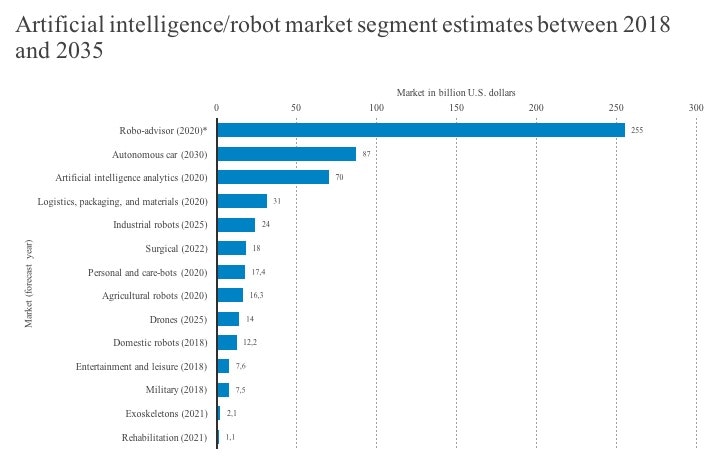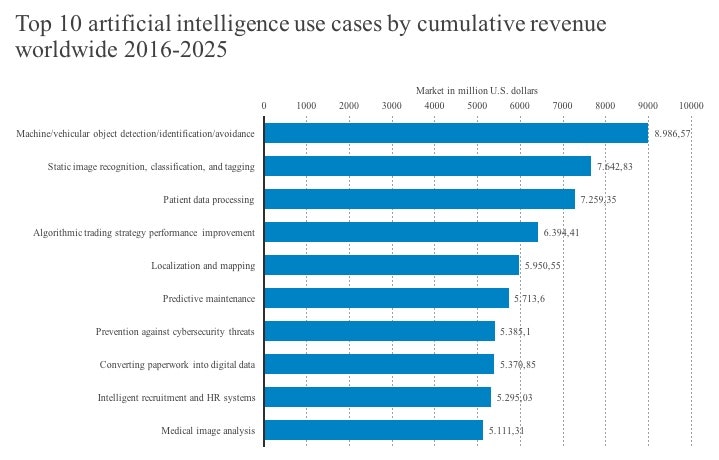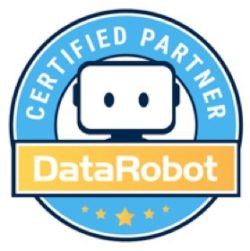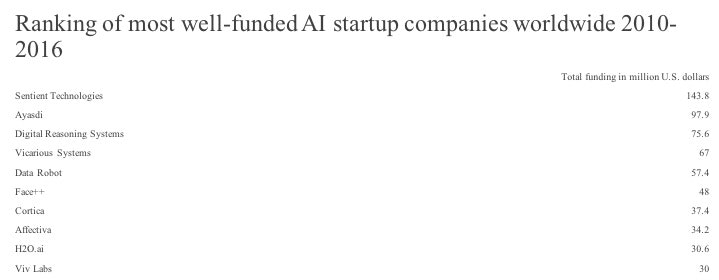Article
Market expectations for artificial intelligence

We analyze the industry’s key indicators and growth forecasts
One of the pillars of the Fourth Industrial Revolution is artificial intelligence (AI). Along with the Internet of things, machine learning, the cloud, and robotics, these technologies are already influencing how businesses are organized, and they will have a decisive impact on the markets of various segments.
Some examples of the uses and applications of AI that are currently being worked on are process automation, learning, issue resolution, processing natural language, and detecting surrounding elements.
To understand the industry trends and scope, we will review some of the key indicators and growth forecasts.
In just seven years, global revenues are expected to multiply by 15 and reach more than $59 billion.

The market segment with the most growth potential in robotics—one of the fields within AI—is that of robo-advisors, followed by self-driving vehicles, analytics, logistics, and industrial robots:

In terms of accrued revenue, the artificial intelligence usage ranking was headed by the detection of vehicles, machines, and objects; static image recognition; and patient data processing.

The startups that have raised the most funding are Sentient Technologies (founded by the creators of the technology that later served as the foundation of Siri), Ayasdi (focused on analyzing and building predictive models), and Digital Reasoning (offers cognitive computing solutions to intelligence agencies and financial institutions).
The fifth position is held by DataRobot, Nae’s partner in the development of big data and machine learning solutions. DataRobot develops automated solutions for machine learning, which is one of the artificial intelligence fields with the most applications at this time.


In relation to the latest World Economic Forum in Davos, where artificial intelligence was mentioned in multiple sessions, Peter Sondergaard, Head of Research & Advisory at Gartner, shared some thoughts on the main challenges:
The media insists on a scenario involving job losses, but this is not accurate. The aim of AI is to augment human capacity by increasing productivity and making our work faster and more precise. Although 1.8 million jobs are expected to be lost by 2020, 2.3 million jobs will be created.
AI has caught the attention of leaders from all industries and regions, but the technology is still at an early stage. Few organizations have implemented large-scale projects. However, many CIOs are considering the idea of launching pilot projects. The recommendation is to focus on the successes and mistakes of pioneers, apply the technology to business priorities, go beyond automation processes to avoid missing other opportunities, and focus on improving processes, customer satisfaction and benchmarking
One of the limitations of AI is data bias. In other words, our data will be as good as its programmers or users, and the results will be as good as the baseline data. If these elements are partial or do not represent the diversity of society as a whole, the results will be biased. An example is the importance of the role that women play in developing these technologies so as to avoid the gender gap.
Along with 5G and the Internet of things, AI is expected to pop up in many headlines at the next Mobile World Congress. All the sessions dealing with artificial intelligence are listed in this link.
Sources: Tractica, Bank of America, Merrill Lynch, and CB Insights.

